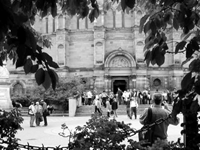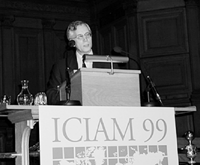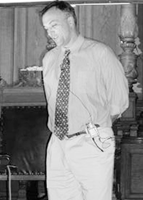Fourth ICIAM Is Held in Edinburgh
September 23, 1999

The University of Edinburgh's McEwan Hall, site of many ICIAM 99 activities. Photographs of ICIAM 99 by J.C. Eilbeck, courtesy of Heriot-Watt University.
The fourth International Congress on Industrial and Applied Mathematics, held in Edinburgh, July 5-9, drew some 1700 participants to the beautiful old city for an intense week. Organized jointly by the Institute of Mathematics and its Applications and the International Centre for Mathematical Sciences, with the mathematics departments of Edinburgh and Heriot-Watt Universities, ICIAM 99 followed in many ways in the tradition of its predecessors (in Paris, Washington, and Hamburg) and moved off in new directions in others.
From a reporter's point of view, one very good innovation introduced by the organizers was a wrap-up session, with speakers who took their charge seriously---presenting not only their personal preferences among the sessions they attended but also considering the evolution of the field and the raison d'�tre of ICIAM. In fact, most participants seemed happy to gather for a final plenary session, to reflect on the week, comparing their own impressions with those of the three speakers---Robert Mattheij (Technische Universiteit Eindhoven), Hilary Ockendon (Oxford University), and Marco Avellaneda (Courant Institute of Mathematical Sciences). (For a personal perspective on the meeting, see Bob O'Malley's "trip report"; look for further coverage in upcoming issues of SIAM News.)

As the mathematical sciences become ever more pervasive in science, engineering, and technology, said Robert Mattheij of the Technische Universiteit Eindhoven in the ICIAM 99 wrap-up session, ICIAM emerges as "an ideal place to learn from other disciplines."
Bringing People Together, Letting Them Interact
"ICIAM is an ideal place to learn from other disciplines," said Mattheij, considering the increasingly interdisciplinary nature of applied and industrial mathematics. Offering level set methods, quasi-Monte Carlo methods, and genetic algorithms as examples of cross-disciplinary mathematics at ICIAM 99, he also pointed to some of the areas in which ICIAM speakers had revealed significant progress: the solution of inverse problems, increased computational speed of algorithms like the fast multipole method, and parallel computing. Ockendon, interested mainly in mathematics in industry, considered ways in which ICIAM helped bring the two together. In the case of industry reaching out to academia, she had one novel feature of the meeting to cite: the first industrial booth at ICIAM. Jaguar, in addition to a glossy brochure testifying to the use of mathematics in all aspects of car design, had made a substantial commitment by sending three or four employees to the meeting. Ockendon also cited the meeting's industry-sponsored sessions, including the two very enthusiastically received Schlumberger Lectures (on modeling the Internet, by F.P. Kelly, and on quantum computing, by S. Popescu).
As to the success of academia in reaching out to industry, Ockendon signaled the success of several plenary speakers in making complicated areas of mathematics accessible to a wide audience. Her examples included the invited talks on liquid crystals and interface motion and the two Schlumberger talks mentioned earlier; those speakers, she said, were exceptional for the way in which they engaged with the audience.
The focal point for Avellaneda was one subset of industrial mathematics: financial applications. His own invited talk, "New Perspectives on Modeling Financial Risk," led off a special day-long meeting on financial mathematics, co-organized by the Society of Actuaries. The approximately 50 participants in the sessions included traders and risk managers (mostly from Edinburgh and London, accounting Avellaneda said, for "the suits you may have noticed").

"The path from classical applied mathematics to the modern world is called modeling," said Marco Avellaneda of the Courant Institute of Mathematical Sciences at the ICIAM 99 wrap-up session. As an invited speaker in the special-interest sessions on financial mathematics earlier in the week, he considered new approaches to the modeling of financial risk.
Minisymposium topics on the program included risk management and models for pricing derivative securities. England is one of the few places where markets have been open since the 1700s, Avellaneda pointed out, which made the historical perspective provided by one speaker from Edinburgh particularly appealing.
Looking at the big picture, from the first ICIAM (Paris, 1997) to the Edinburgh meeting, Avellaneda saw a stronger use of high-performance computing (parallel computing was the topic of another day-long special-interest meeting within ICIAM 99), more sophisticated algorithms for solving real-world problems, and a stronger interaction between mathematics and technology.
Computational science and engineering (CS&E) came in for special attention at the meeting, Mattheij pointed out, with several attempts to define the concept more precisely. More and more universities are introducing CS&E curricula, he concluded. "CS&E will probably redefine the role of mathematics in the future."
Ockendon concluded her presentation with the results of her own small survey of colleagues as to what they had found most exciting about the meeting:
- Superconductivity, as presented by a lively, truly international group that was generating lots of new ideas; this group showed "what a minisymposium should be."
- Knot theory, in applications to dynamics and fluid mechanics; again, these sessions demonstrated how people are brought together.
- Solutions to Maxwell's equations, a particularly pleasing topic for a meeting held in Edinburgh (the birthplace of James Clerk Maxwell), whether arranged intentionally or not. This was the theme of three plenary talks and several minisymposia; that finite element methods are applicable to Maxwell's equations was the breakthrough.
- Nonlinear optics.
- Numerical prizes, particularly the Wilkinson prize, in being awarded to two young people, one in mathematics, the other in physics.
- The general-interest minisymposia, e.g., Industrial Research Successes, sponsored by the Association for Women in Mathematics, European Women in Mathematics, and SIAM.
A meeting like ICIAM, Ockendon said in summary, is valuable "for bringing people together and letting them interact. . . . I at least learned a lot from coming here."
Random Impressions
Finally, from a few participants who made it back to their computers in time to provide input for this issue of SIAM News:
Hans Kaper of Argonne National Laboratory had high praise for the conference organization, including the Web pages, but lamented the "minor presence" of scientific computing in the (generally "too academic") program. As highlights, he cited the invited talks of Jonathan Chapman and Stefan M�ller and the series of minisymposia on materials organized by Irene Fonseca and David Kinderlehrer as "excellent examples of good applied mathematics . . . with a good mix of theory and experiment in the minisymposia."
Tony Chan of UCLA and Chuck Gartland of Kent State University joined many in voicing their appreciation for the invited talk of Jamie Sethian. Gartland was impressed both by the diversity of the applications of level set and fast marching methods and by Sethian's "on-the-fly" prowess with a laptop. The organizer (with Frank Leslie) of a session on liquid crystals, Gartland also found much to like in Chapman's invited talk ("the analogies/parallels between dense vortices in superconductors and vorticity in fluids were very effective"), in the minisymposia on computational electromagnetics and materials, and, of course, in Epifanio Virga's invited talk on liquid crystals.
Chris Jones of Brown University, the organizer (with Bj�rn Sandstede) of a session on optical communications, found the talks on the Internet and communications particularly interesting. Frank Kelly's talk on modeling the Internet ("the best plenary talk I heard") impressed Jones for its characterization of the problems at different scales (the individual fiber level, small local networks, and the global large-scale network). "It struck me as extraordinary," he told SIAM News, "that a subject only ten years old could have spread onto such a variety of levels."
Gene Golub of Stanford University found in the program "a more traditional view of applied mathematics" . . . without much emphasis on modern applied mathematics such as combinatorial problems and scientific computing." Two things that did win his approval: the "warm, friendly and helpful" people in Edinburgh, and the presentation at the meeting of two SIAM prizes---the Dahlquist Prize, to Linda Petzold, and the first Henrici Prize, to Germund Dahlquist, "one of the giants of modern numerical analysis," who, beyond his scientific contributions, has "acted as the godfather for several generations of scientists."
Uri Ascher of the University of British Columbia found his interest in Maxwell's equations well satisfied at ICIAM 99, in several minisymposia and contributed sessions. His hope for future meetings: "less politics in the entire organizational process."
In agreement on the latter point was Tony Chan, who, having attended both ICIAM and the International Congress of Mathematicians in Berlin last August, came away with some ideas for future ICIAM organizers:
"I notice a drastic difference in how these two conferences are organized. The ICM is organized according to disciplines, and speakers are invited by small committees in each area, regardless of nationality. The ICIAM meeting seems to have one big committee, and it must have been difficult to overcome 'political' issues in such a committee. For example, there seems to be a very conspicuous national representation in the selection of the plenary speakers, as well as the prize winners. Not to take anything away from the quality of the individuals, but the contrast with the ICM is stark. Even though I realize that it is much more difficult to organize the ICIAM meetings according to well-defined technical areas, I think there are some good points that we can learn from the ICMs."Noel Barton of CSIRO, who concluded the wrap-up session with some tantalizing words on ICIAM 03, to be held in Sydney, Australia, clearly has an interested audience waiting to see how the program unfolds.

As ICIAM 99 drew to a close, Noel Barton of CSIRO looked ahead to ICIAM 03, to be held in Sydney, Australia.

